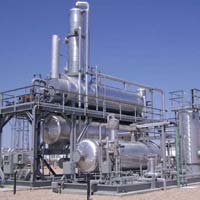
TEG Gas Dehydration Technology
Get Price Quote
TEG Gas Dehydration Technology We have developed Glycol Dehydration Unit, which is suitably utilized for dehydrating glycol. Most natural gas producers use Triethylene glycol (TEG) to remove water from the natural gas stream in order to meet the pipeline quality standards. This process is required to prevent hydrates formation at low temperatures or corrosion problems due to the presence of carbon dioxide or hydrogen sulfide (regularly found in natural gas). Dehydration, or water vapor removal, is accomplished by reducing the inlet water dew point (temperature at which vapor begins to condense into a liquid) to the outlet dew point temperature which will contain a specified amount of water. Absorption of water vapor in the TEG is the common method. The wet gas is brought into contact with dry glycol in an absorber. Water vapor is absorbed in the glycol and consequently, its dew point reduces. The wet rich glycol then flows from the absorber to a regeneration system in which the entrained gas is separated and fractionated in a column and reboiler. The heating allows boiling off the absorbed water vapor and the water dry lean glycol is cooled (via heat exchange) and pumped back to the absorber. Features � Process guaranty � Efficient energy saving

vegetable dehydration plant
Get Price Quote
Best Deals from Vegetable Dehydration Plant